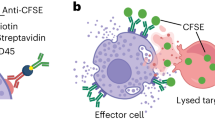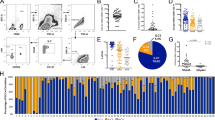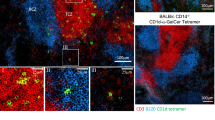Abstract
This protocol describes methods to identify, purify and culture CD1d restricted invariant natural killer T (iNKT) cells from mouse tissue or human blood samples. The methods for identification and purification of iNKT cells are based on the interaction between iNKT cell receptor and its ligand. The iNKT cell receptor is composed of the invariant Vα14Jα18/Vβ8.2 in mice or Vα24Jα18/Vβ11 in humans and is expressed only on iNKT cells but not on conventional T cells. The iNKT cell antigen receptor in both species recognizes α-galactosylceramide (α-GalCer) presented by the MHC class I-like CD1d. Thus, α-GalCer-loaded CD1d dimer can be used for analysis and purification by fluorescence-activated cell sorting (FACS). Isolation of 1 × 106 purified iNKT cells from mouse thymus, spleen or liver requires 5–6 mice and takes 1–2 h for mononuclear cell preparation from mouse tissues, 1.5 h for enrichment by magnetic beads and 4 h for detection and purification of the iNKT cells by FACS. In the case of isolation of human peripheral blood mononuclear cells (PBMCs) from whole blood, it takes 2 h and requires 5 ml of blood to obtain 5 × 106 PBMCs, which contain 500–25,000 iNKT cells.
This is a preview of subscription content, access via your institution
Access options
Subscribe to this journal
Receive 12 print issues and online access
$259.00 per year
only $21.58 per issue
Buy this article
- Purchase on Springer Link
- Instant access to full article PDF
Prices may be subject to local taxes which are calculated during checkout


Similar content being viewed by others
References
Taniguchi, M., Harada, M., Kojo, S., Nakayama, T. & Wakao, H. The regulatory role of Valpha14 NKT cells in innate and acquired immune response. Annu. Rev. Immunol. 21, 483–513 (2003).
Wilson, S.B. & Delovitch, T.L. Janus-like role of regulatory iNKT cells in autoimmune disease and tumour immunity. Nat. Rev. Immunol. 3, 211–222 (2003).
Brigl, M., Bry, L., Kent, S.C., Gumperz, J.E. & Brenner, M.B. Mechanism of CD1d restricted natural killer T cell activation during microbial infection. Nat. Immunol. 4, 1230–1237 (2003).
Taniguchi, M., Seino, K. & Nakayama, T. The NKT cell system: bridging innate and acquired immunity. Nat. Immunol. 4, 1164–1165 (2003).
Fujii, S., Shimizu, K., Smith, C., Bonifaz, L. & Steinman, R.M. Activation of natural killer T cells by alpha-galactosylceramide rapidly induces the full maturation of dendritic cells in vivo and thereby acts as an adjuvant for combined CD4 and CD8 T cell immunity to a coadministered protein. J. Exp. Med. 198, 267–279 (2003).
Lantz, O. & Bendelac, A. An invariant T cell receptor α chain is used by a unique subset of MHC class I-specific CD4+ and CD4-8 T cells in mice and humans. J. Exp. Med. 180, 1097–1106 (1994).
Exley, M., Garcia, J., Balk, S.P. & Porcelli, S. Requirements for CD1d recognition by human invariant Vα24+CD4CD8 T cells. J. Exp. Med. 186, 109–120 (1997).
Zhou, D. et al. Lysosomal glycosphingolipid recognition by NKT cells. Science 306, 1786–1789 (2004).
Speak, A.O. et al. Implications for invariant natural killer T cell ligands due to the restricted presence of isoglobotrihexosylceramide in mammals. Proc. Natl. Acad. Sci. USA 104, 5971–5976 (2007).
Porubsky, S. et al. Normal development and function of invariant natural killer T cells in mice with isoglobotrihexosylceramide (iGb3) deficiency. Proc. Natl. Acad. Sci. USA 104, 5977–5982 (2007).
Morita, M. et al. Structure-activity relationship of α-galactosylceramides against B16-bearing mice. J. Med. Chem. 38, 2176–2187 (1995).
Kawano, T. et al. CD1d-restricted and TCR-mediated activation of Vα14 NKT cells by glycosylceramides. Science 278, 1626–1629 (1997).
Borg, N.A. et al. CD1d-lipid-antigen recognition by the semi-invariant NKT T-cell receptor. Nature. 448, 44–49 (2007).
Tynan, F.E. et al. T cell receptor recognition of a 'super-bulged' major histocompatibility complex class I-bound peptide. Nat. Immunol. 6, 1114–1122 (2005).
Kawakami, K. et al. Critical role of Vα14+ natural killer T cells in the innate phase of host protection against Streptococcus pneumoniae infection. Eur. J. Immunol. 33, 3322–3330 (2003).
Nieuwenhuis, E.E. et al. CD1d-dependent macrophage-mediated clearance of Pseudomonas aeruginosa from lung. Nat. Med. 8, 588–593 (2002).
Gonzalez-Aseguinolaza, G. et al. Natural killer T cell ligand α-galactosylceramide enhances protective immunity induced by malaria vaccines. J. Exp. Med. 195, 617–624 (2002).
Cui, J. et al. Requirement for Vα14 NKT cells in IL-12-mediated rejection of tumors. Science 278, 1623–1626 (1997).
Smyth, M.J. et al. Differential tumor surveillance by natural killer (NK) and NKT cells. J. Exp. Med. 191, 661–668 (2000).
Nakagawa, R. et al. Mechanisms of the antimetastatic effect in the liver and of the hepatocyte injury induced by α-galactosylceramide in mice. J. Immunol. 166, 6578–6584 (2001).
Kojo, S. et al. Induction of regulatory properties in dendritic cells by Valpha14 NKT cells. J. Immunol. 175, 3648–3655 (2005).
Hammond, K.J. et al. α/β-T cell receptor (TCR)+ CD4−CD8− (NKT) thymocytes prevent insulin-dependent diabetes mellitus in nonobese diabetic (NOD)/Lt mice by the influence of interleukin (IL)-4 and/or IL-10. J. Exp. Med. 187, 1047–1056 (1998).
Nakamura, T. et al. CD4+ NKT cells, but not conventional CD4+ T cells, are required to generate efferent CD8+ T regulatory cells following antigen inoculation in an immune-privileged site. J. Immunol. 171, 1266–1271 (2003).
Ikehara, Y. et al. CD4+ Vα14 natural killer T cells are essential for acceptance of rat islet xenografts in mice. J. Clin. Invest. 105, 1761–1767 (2000).
Seino, K.I. et al. Requirement for natural killer T (NKT) cells in the induction of allograft tolerance. Proc. Natl. Acad. Sci. USA 98, 2577–2581 (2001).
Liu, Y. et al. A modified α-galactosyl ceramide for staining and stimulating natural killer T cells. J. Immunol. Methods 312, 34–39 (2006).
Greten, T.F. et al. Peptide-beta2-microglobulin-MHC fusion molecules bind antigen-specific T cells and can be used for multivalent MHC-Ig complexes. J. Immunol. Methods 271, 125–135 (2002).
Naidenko, O.V. et al. Binding and antigen presentation of ceramide-containing glycolipids by soluble mouse and human CD1d molecules. J. Exp. Med. 190, 1069–1080 (1999).
Hammond, K.J.L. et al. CD1d-restricted NKT cells: an interstrain comparison. J. Immunol. 167, 1164–1173 (2001).
Sidobre, S. & Kronenberg, M. CD1 tetramers: a powerful tool for the analysis of glycolipid-reactive T cells. J. Immunol. Methods 268, 107–121 (2002).
Karadimitris, A.S. et al. Human CD1d-glycolipid tetramers generated by in vitro oxidative refolding chromatography. Proc. Natl. Acad. Sci. USA 98, 3294–3298 (2001).
Acknowledgements
We thank Etsuko Sekine, Sayo Inoue, Sakura Sakata and Yuko Nagata for their technical support; Professor Peter D. Burrows for critical reading; and Norie Takeuchi for secretarial assistance.
Author information
Authors and Affiliations
Corresponding author
Rights and permissions
About this article
Cite this article
Watarai, H., Nakagawa, R., Omori-Miyake, M. et al. Methods for detection, isolation and culture of mouse and human invariant NKT cells. Nat Protoc 3, 70–78 (2008). https://doi.org/10.1038/nprot.2007.515
Published:
Issue Date:
DOI: https://doi.org/10.1038/nprot.2007.515
This article is cited by
-
Innate lymphocytes: pathogenesis and therapeutic targets of liver diseases and cancer
Cellular & Molecular Immunology (2021)
-
Thymic resident NKT cell subsets show differential requirements for CD28 co-stimulation during antigenic activation
Scientific Reports (2020)
-
Invariante natürliche Killer-T-Zellen
Der Pathologe (2020)
-
CD160 serves as a negative regulator of NKT cells in acute hepatic injury
Nature Communications (2019)
-
Palmitate inhibits arthritis by inducing t-bet and gata-3 mRNA degradation in iNKT cells via IRE1α-dependent decay
Scientific Reports (2017)
Comments
By submitting a comment you agree to abide by our Terms and Community Guidelines. If you find something abusive or that does not comply with our terms or guidelines please flag it as inappropriate.



